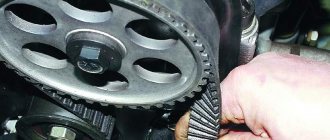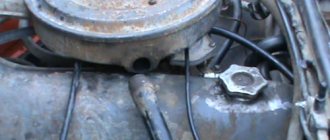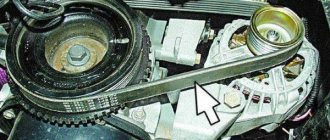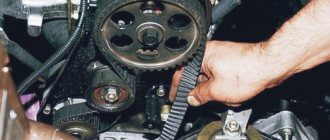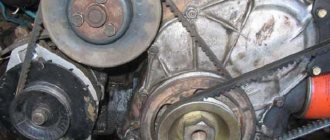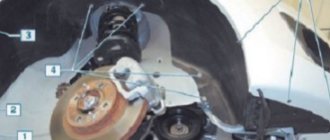If the crankshaft and camshaft gears have worn, worn-out teeth, this can be the main reason for extremely rapid wear of the timing belt.
Broken camshaft tooth
You can determine the wear of the gears by eye - if some teeth are ground down, broken off, or missing altogether, then this is a direct indication for their replacement; there are no other options. In some cases, the situation can be aggravated by an oil leak - when it gets on the belt, it (like many other petroleum products) causes it to corrode and quickly peel off the teeth.
Belt care instructions
Above we listed the main reasons for timing belt wear, now we’ll add a few words about how to extend its service life.
To do this you need:
- periodically (at least once a month) check the degree of belt tension and, if necessary, adjust it;
- before installing a new belt, treat all gear teeth with white spirit;
- avoid contact of gasoline and technical oils with the surface of the belt;
- replace the belt at least every 60,000 km (teared teeth and drops of oil on the belt significantly reduce this figure);
- periodically check the condition of the tension roller (if a whistle appears after replacing the belt, this means that the roller is already worn out and a new one should be purchased and installed).
Oil on the timing belt VAZ 2114
In conclusion, it should also be added that the pattern of two or three teeth torn off on the belt is a consequence of the water pump being jammed. To avoid such a situation in the future, it should be replaced after draining the coolant from the system.
CHEVROLET Lanos
A budget car, which, in addition to wiping the canvas, has a lot of small and large breakdowns. But, despite the dubious quality of some spare parts, Lanos still earned respect from car enthusiasts.
To extend the service life of the belt, you must follow the driving rules - do not press the gas all the way when in low gear.
1200 rub. for the photo report
We pay for photo reports on car repairs. Earnings from 10,000 rubles/month.
Many owners of front-wheel drive VAZs are concerned about the problem of why the timing belt is eating ? Most often this question is asked by owners of the following VAZ models - 2108, 2109, 2110, 2112, 2114, Kalina, Priora, Grant (and this problem occurs on engines with both 8 and 16 valves). There is only one general answer to the question raised: the belt is skewed. And this, in turn, can happen for a number of reasons - the pump is installed unevenly, the roller is of poor quality, a washer of the wrong size is installed between the roller and the block (or it is missing altogether) and some others. Each of the listed problems is solved in its own way. In most cases, work to eliminate the causes can be carried out independently, provided you have the appropriate experience and tools. This will save money, and the repair work itself does not take much time and effort.
Reasons why the timing belt eats on a VAZ-2114
Most often, a similar problem is observed after work to replace the belt, or any component elements, that is, pulleys, water pump, or tension roller.
Pump and tension roller with signs of wear.
Therefore, it is important, before starting work on installing a new timing belt, to check the tension roller itself, the water pump and the pulleys . They should rotate freely, without making unnecessary noise or crackling.
Diagnostics of the tension roller stud
Pay special attention to the condition of the tension roller pin; it should not have any visible damage, be bent, etc.
Belt tension
Correct tension setting
To eliminate the facts of “eating” the belt, it is necessary to take care of its correct tension, because weak tightening will not be effective when the engine is running, also in this case the belt has a much greater chance of slipping by several teeth, and its excessive tension can cause a rapid rupture.
When you have replaced the belt, do not rush to put the protective cover on it, since the first step is to determine whether the belt is installed correctly by comparing all the marks, and then start the engine.
When monitoring its operation, evaluate its position on the engine, making sure that it does not touch any parts of the engine or body with its outer working surface. Also pay attention to its position on the pulley, because it should not go beyond the edge.
Step-by-step replacement instructions
The VAZ 2109 car is designed in such a way that if repair work is necessary, it can be carried out by the car owner himself. The process of changing the tensioner roller is quite simple, and it will take no more than 1.5 hours.
Step-by-step instructions for carrying out technical work on the timing system:
hidden spring roller
roller with external spring design
If after the work carried out, the car owner has no complaints about the operation of the engine, then the process of replacing the timing rollers in the engine is over.
Malfunctions after replacing timing rollers
In most cases, after replacing the timing belt tensioners, the car owner does not encounter any problems. However, as practice has shown, malfunctions can manifest themselves after some time.
Malfunctions and solutions:
Fault 1: The battery does not charge well; after several hours of inactivity, the car does not start. Voltage drops are also observed in the on-board electrical network.
Solution: Most likely, when installing the timing belt, the driver incorrectly adjusted the position of the shaft gears in relation to the generator gear. As a result, malfunctions in the on-board network began to appear. They arise due to the asynchronous operation of the gears described above. To eliminate this problem, you just need to debug the position of the shaft gears and the generator. After additional configuration, the problem goes away.
Malfunction 2: After replacing the rollers, the timing belt cracked or even broke.
Solution: In most cases, this problem occurs when a modified timing panel panel is installed. Such breakdowns occur due to the fact that the position of the rollers was not calibrated, as a result of which the belt was overtightened. To eliminate this problem, remove one of the rollers, then put on the belt. After this, install the removed roller back on the panel. Then adjust its position. The adjustment itself must be carried out using a special wrench, which must be used to tighten additional screws on the tensioner. When adjusting the position of the roller, you should also rotate the belt to ensure that there is no excessive pressure on it.
Other causes of timing belt wear
One of the camshaft teeth is broken.
Another reason why increased belt wear may occur is severe wear of the teeth on the gears, crankshaft and camshaft.
As a rule, such a problem can be noticed with the naked eye, and belt failure begins with the peeling of the teeth themselves from the belt.
A more significant cause of such a malfunction can be oil leakage from the engine, which gets onto the belt during operation, thereby wearing it out faster. An oil leak is also easy to notice, but eliminating it will require certain skills.
Such problems in the form of oil leaks can damage the timing belt.
It also happens that the cause of a belt rupture may be poor-quality material from which it is made. It often happens that when producing belts from reputable manufacturers, fakes are encountered.
How to fix the problem
The video explains in detail how to get rid of this problem.
Didn't find the information you are looking for? on our forum.
We recommend reading:
The wipers stopped working on a VAZ 2107
Instrument panel VAZ 2106 description of lamps and indicators
Where is the mass located on the VAZ 2110?
Thresholds for VAZ 2110 from Priora
Where is the engine number on the VAZ 2109, markings and decoding by year
VAZ 21 12 starter relay where is it located
Wiring diagram for VAZ 2106, color, with description, in good quality
Instrument panel for VAZ 2112 europanel. Installation instructions
The main 9 reasons why the timing belt eats
There are a huge number of reasons for belt slipping and wear, but there are also the main culprits of this problem, which are described below.
Poor quality belt
As you know, there are quite a lot of fakes for domestically produced cars, and it is very easy to run into a clandestinely manufactured timing belt. A fake belt may have an irregular shape, namely an oval center, or, on the contrary, any of the edges may be uneven, similar to a cone, which will lead to inevitable distortion of the belt and soon it will slide in different directions. Such problems occur due to incorrect or broken belt production technology.
Belt tension
Incorrect belt tension contributes to the rapid eating of the belt or its breakage, which can lead to dire consequences and expensive repairs of the internal combustion engine. It is necessary to tension the belt correctly, following the manufacturer's recommendations.
Roller bolt and stud
A stud and bolt are necessary to secure the timing belt tensioner and idler pulley. When they are skewed, the alignment of the mechanism elements is disrupted, as a result of which the belt begins to walk along the pulleys, which leads to its rapid wear.
Thread
The threads in the cylinder head or the block itself may be damaged, which will lead to inevitable misalignment of the pin or bolt securing the rollers. And as described above, the misalignment of this pin threatens to warp the belt and cause it to slide towards the misalignment.
water pump
The pump has a bearing in its design, which is subject to aging and over time can slightly tilt the water pump pulley, which will lead to the belt slipping and being eaten.
Incorrectly installed pump
When replacing the pump, it is possible that some of its mounting bolts will be looser, which, under the influence of belt tension, can lead to its distortion.
Roller wear
Timing rollers in new modifications of VAZ cars are made of plastic. This plastic, although super strong, is still susceptible to wear and over time can wear into a cone shape, which can cause the timing belt to slip.
Camshaft gear wear
With a mileage reaching 150 thousand km, wear on the camshaft gears is common. This problem occurs quite often after reaching this mileage.
Crankshaft gear wear
The most likely problem with a timing belt eating is the crankshaft gear. Under the influence of various dirt and sand, which gets under the belt and wears out the gear, which will inevitably lead to misalignment, eating and wear of the belt.
Reasons for slipping
ATTENTION! A completely simple way to reduce fuel consumption has been found! Don't believe me? An auto mechanic with 15 years of experience also didn’t believe it until he tried it. And now he saves 35,000 rubles a year on gasoline! Read more"
As a rule, the complications of a 1.5-liter eight-valve internal combustion engine after a routine scheduled change of a rubber timing belt product that has “plowed away” its issued life are familiar to many owners. It consists in the fact that the new part now jumps off, which inevitably leads to its breakage. If on such engines, when the rubber ring ruptured, mutual collision of the valve-piston elements was observed, major repairs would have been impossible to avoid.
But on a 16-valve unit, the results of a timing ring rupture are much sadder. In this case, stopping the engine alone will not end.
On the other hand, why does the belt still slide out? And this happens both towards the power plant and vice versa. Well, how long can you change the belt, it’s time to find the cause and eradicate it.
Reason 1: the culprit is the belt
The fact that these days the quality of new parts does not stand up to criticism does not surprise anyone. And it would be correct to say that the main factor in the slippage is precisely the unoriginality and poor quality of the timing belt. It is no secret that a rubber element with an uneven structure, which tends to stretch differently in certain places, is no longer an option. Such a belt will always have a misalignment, albeit imperceptible to the eye, but extremely negatively affecting the operation of the part.
Note. You can check the belt crookedness as follows. It is necessary to turn it over on the drive, and then diagnose operation in this position. If the belt starts to slip in the other direction, the problem is in the belt itself.
The mistake of the manufacturer, who allowed the product to be defective, gives us a belt with different rigidity in width. As a result, the rubber part, under the influence of force, “floats” in the direction of less elasticity. And this happens virtually immediately after installation.
Reason 2: pump
The second common cause is related to play in the coolant pump shaft. Popularly, this problem is called “pump overshoot.” The presence of play is quite easy to determine: you need to remove the belt and check the pump gear for rolling. If there is play, the pump will have to be replaced, since sooner or later it will completely fail, if this has not already happened.
Often the pump is simply made crookedly. Maybe the turner was busy with this, or something else, but this really happens. In addition, problems often begin after replacing the pump with a new one. In this case, it is recommended to check how the mating surface of the block is cleaned. It is quite possible that when installing a new pump, the mating area was poorly cleared of pieces of the old gasket. As a result, the pump was out of place, skewed.
Finally, over time, your pump bearings can wear out, causing performance problems.
Reason 3: NTZh video
The third common reason is the tension roller or NTJ. Being a high-precision device, it does not accept any deviations, even the smallest. The correct operation of the NTZ roller depends on the accuracy of the characteristics of its components. In the case of a belt slipping, everything is simple: if the HTZ roller is initially crooked, it will begin to move the rubber timing ring to the side, thereby wearing out the edge of the rubber part.
In addition, the most common cause of belt slippage problems associated with the HTJ roller is a bent locking pin. This happens, again, during an “amateurish” replacement of the roller, when the tightening is not carried out at the proper level. Any specialist will confirm that it is impossible to tighten the ex nut, since the pin can easily bend, and any discrepancy, as mentioned above, has a negative effect on the sensitive roller.
It is almost impossible to straighten this hairpin. On the other hand, there is an option to turn it out of the block and then put it back.
But there is another effective way. You need to cut washers the size of a spacer ring out of a tin can, and then place them between the block and the eccentric of the NTZh roller.
This method will also help resolve complications with the timing rubber ring coming off:
- If the belt slips towards the motor, it is recommended to place homemade washers closer to the block.
- If the belt slips away from the motor, then it is advisable to place washers closer to the edge.
Note. It is recommended to place the washers on silicone to prevent them from falling.
The thickness of the washers is selected depending on the situation. If you need to reduce the size of the washer, simply cut it into two halves with a crescent shape. If you enlarge it, bend it in half.
It will be useful to know that some car owners recommend installing an old-style roller on the NTZh Vasa. It has a different design compared to the NTZh of the latest samples.
Of course, the problem with the belt slipping cannot be solved by replacing the HTZ roller, but it will be easier to determine belt wear. Let us remind you that the old-style roller has a metal side, while the modern one has a plastic side. It turns out that the old-style NTZ roller will eat up the belt more noticeably than a part with a plastic side.
In some cases, a snag with the timing rubber ring can be resolved by tightening the tensioner in the direction of the camshaft. In this case, a large break point will form on the upper part of the ring, but this may adversely affect the correct functioning conditions of the entire GDS mechanism.
It would be more correct when replacing the NTZ roller with a new one, to pay attention to the quality of the product. As mentioned above, modern products not only give in to older models in terms of side material, but are also made on a 1-row ball bearing. In addition, the surface of the NTZ rollers may be far from ideal: cone, oval, and even steps are common.
And of course, you need to carefully check the NTZ roller for play (it must be negligible) and for a surface without protrusions or irregularities.
Finally, during installation, you need to check whether there is grease in the roller bearings. Don’t be surprised, nowadays they can save even on this.
Methods for eliminating belt eating
Below are examples of eliminating the causes of belt wear and eliminating the causes of belt eating.
Fake belt
A poor-quality belt may be the culprit of the problem; in order to check this, you need to turn the belt over and try to start the engine; if the belt starts to slide in the other direction, then most likely the plane of the belt is uneven and has a cone shape, which leads to it slipping and being eaten. This problem is treated by replacing it with a new, higher quality belt.
Incorrect tension
The timing belt must be tensioned as recommended by the manufacturer. This information can be found in specialized books on VAZ car repairs or on the Internet. Over-tightening the belt places a load on the bearings and can cause wear on both the rollers and the pump.
crooked hairpin
As a result of the efforts when tightening the roller, it happens that the roller pin becomes slightly bent and, as a result, the roller tilts. This problem will lead to belt misalignment.
The problem is solved by replacing the stud with a new one or placing half washers under the roller in order to correct the tilt of the stud and align the roller.
Thread damage
Damage to the threads, as well as bending the stud, can change the trajectory of the belt. This problem is solved by unscrewing the stud and running the threads with a sword. In the worst case, it is necessary to dismantle the cylinder head to bore or restore the threads.
Water pump
When the pump receives any damage or wear, no action other than replacing it can be taken. If the culprit is the pump, it must be replaced.
Pump misalignment
The problem is that when installing a new pump, most car enthusiasts often use sealant or do not clean the surface of the old gasket. All these points can affect the tightness of the water pump to the block body, which can affect the trajectory of the timing belt. You should thoroughly clean the surface on the cylinder block from the remains of the old gasket and do not use sealant; just install the gasket that comes with the pump.
Working on rollers
The rollers, like the pump, are subject to aging and wear, and in case of such problems, the rollers only need to be replaced; any other methods of correcting belt wear due to the rollers are impossible
Camshaft gear wear
The camshaft gear is made of soft metal, which can quickly wear out and wear out. Most often, the gear wears out already at a mileage close to 150 thousand. If this problem occurs, the gears must be replaced.
Crankshaft gear
Most often, the crankshaft gear wears to a cone and the belt begins to move outward, which leads to friction on the spacer washer between the gear and the accessory drive pulley. Because of this situation, the belt can squeak and howl, and in most cases of this situation, the belt eats up.
The problem is solved by replacing the crankshaft gear.
We hope our article was useful to you.
Such a problem as the timing belt slipping from the place of fixation is common, and this is most often due to poor-quality materials of the belt itself and its component elements. Below we will tell you how to avoid such a situation, and how to prevent the unwanted consequences of such a breakdown.
The video shows how the timing belt slips on a VAZ-2114:
Using shims when the belt slips
You can make washers yourself, for example, from the body of aluminum beer cans, coffee tins, or use ready-made ones from the factory. The main thing is that the washers are the same size as the spacer ring installed between the block and the tension roller eccentric. There are two options. The first uses factory washers. The thickness and quantity are selected experimentally. The use of this method is ambiguous, since the washers are flat and, accordingly, the contact plane of the roller will remain parallel to the same. However, this method has helped some car enthusiasts.
1 - if the belt is sliding towards the engine, 2 - if the belt is sliding away from the engine
Another method is to make your own crescent-shaped washers. The number and width of washers are also selected experimentally. The use of such washers is more expedient, since with their help it is possible to change the angle of inclination of the pin and roller so that it forms a normal to the plane of the cylinder block body.
The washer must be installed according to the diagram shown in the figure. In particular, if the timing belt is slipping towards the engine, then the washer/washers should be installed closer to the center of the block. If the belt moves from the engine, then vice versa, closer to the edge of the block. When installing washers, it is recommended to use a heat-resistant sealant that will keep them from sliding to the side with or without load.
Finally, I would like to note that in rare cases, the cause of the belt shifting to one side or the other and its eating can be caused by not one, but several of the reasons described above. As a rule, the method of using shims is universal and can save the situation in even the most “neglected” cases. However, it makes sense to inspect the belt, roller and pump in order to identify shortcomings in their operation, and, if necessary, replace the listed components. This will save you from having other problems with these parts in the future.
Source
Gas distribution system VAZ-2114
It will not be a secret to anyone that over time, any part will wear out and require replacement; for some, this period is measured in hundreds, for others, tens of thousands of kilometers.
Timing mechanism diagram
As for the gas distribution mechanism system, and specifically its belt, replacement should be done at the end of its service life, or if there is visible damage to it.
However, it should be noted that when replacing an old belt with a new one, a problem may occur such as the belt sliding out of its place, which in turn can lead to eating (wear - approx.) of the edge of the belt, which in the future will only contribute to its wear, break and another replacement.
We hasten to please you
The VAZ-2114 car was equipped only with an 8-valve engine, with a volume of 1.5 and 1.6 liters, which may indicate that when the timing belt breaks, the pistons and valves do not meet and the latter do not bend , which is certainly favorable affects not only subsequent repairs, but also the car owner’s wallet.
Tuning VAZ 2109
In this article, we will look at solutions to the problem of the VAZ 2109 timing belt slipping. As you know, all car parts tend to wear out over time, and sooner or later it becomes necessary to replace one or another worn-out part with a new one. Owners of the VAZ 2109, as well as other front-wheel drive VAZ cars equipped with a 1.5-liter 8-valve engine, often face one problem after replacing the timing belt again. A new timing belt, installed to replace the old one, begins to be pulled from its normal location in the middle of the camshaft drive gear to its edge by an unknown force, which leads to the drive parts eating up the edge of the belt. This leads to rapid wear and thinning of the timing belt, and as a result, its rapid breakage and the need for another belt replacement. It’s good that on these engines, if the timing belt breaks, the desynchronization of the movement of the valves and pistons does not lead to their mutual collision and engine overhaul most likely does not threaten you. The belt can pull both from the engine and in the opposite direction. The author, in the process of solving this problem (yes, it did not escape me either), changed 3 belts before solving it, having tried many methods. I will share these methods with you in this article.
Lately, the quality of spare parts leaves much to be desired, so I believe the main reason for belt slippage is low-quality spare parts, in this case the timing belt itself. It may have an uneven structure, stretch differently in different places, and be skewed if there is even a difference in the diameters of its two edges that is not noticeable to the eye. You can determine whether a newly installed belt is crooked by turning it over on the drive and checking its operation in this position. If it pulls in the other direction, the belt itself is to blame.
Also, belt slipping can be caused by play in the coolant pump shaft, commonly referred to as a pump. It is not difficult to determine the presence of play: with the timing belt removed, shake the pump gear by hand. If there is even the slightest play, the unit needs to be replaced, it won’t have long to live.
Where does the belt slip and why?
Note! The belt can slip either towards the engine or in the opposite direction from it.
This happens regardless of how exactly it was installed in the middle of the gear, since the reason for this is not only the belt itself, but also the elements and mechanisms accompanying its operation. In order to solve this problem, you need to use the methods described below.
Timing belt
In modern times, in the automotive spare parts market, facts of counterfeits and low-quality products are becoming more and more common.
The top is the original timing belt and the bottom is a fake.
Specifically touching on the issue with the timing belt, we can talk about its uneven structure, increased elasticity (the ability to stretch excessively - approx.), as well as the presence of significant differences between the two edges (distortion - approx.).
The degree of straightness of the newly installed belt can only be determined on the mounted mechanism.
And, if even minor deviations are observed after starting the engine, then the reason is in the belt.
Belt is on and tight
water pump
The timing belt can slip due to play in the pump (pump - approx.). It is very easy to determine its presence; you just need to grab the working surface of the gear with your hand, and if there is even the slightest play, the unit must be changed. In this case, read the material: “choosing a reliable pump for the VAZ-2114”
Leaks on the cylinder block from the timing side indicate that the pump has failed
Tension roller
The next element that needs to be diagnosed when the timing belt is slipping is the tension roller.
Although it may seem like a simple part, deviation from its performance specifications can significantly affect the overall correct operation of the part. In simple terms, a curved roller will not be able to provide the belt with linear movement , wearing out and moving it to the side.
The diagram is clear and understandable.
Another reason for discussions on popular forums about the belt moving to the side is the installation of rollers of different types, because the analogue has a different, slightly modified design.
The difference between the rollers
The difference between these two spare parts is that the old side has a different shape, made of metal, while the new one is made of plastic.
Therefore, as the theory shows, a spare part made of plastic causes much less friction than its metal counterpart.
There are two types of rollers.
conclusions
As you have seen for yourself, the reason for the timing belt slipping on a VAZ-2114 can only be solved by replacement, so when choosing a similar spare part in a store, it is best to pay attention to a trusted manufacturer who has proven itself only from the best side.
All car parts can become old and wear out over time. Each car owner, sooner or later, is faced with a situation when a spare part needs to be replaced. The problem of the rubber ring slipping is very common, especially among VAZ owners. Let's find out what the reasons for this are.
Other ways to adjust the roller
If you look at the standard and proper operation of the timing belt, then the tension roller should be located exactly in the middle of the pump and camshaft gears. However, some VAZ-2114 owners, in order to avoid the belt slipping, pull the roller to the side, closer to the camshaft, thus the belt, receiving the greatest bend in its upper part, is more firmly fixed in its place.
All tension roller components for VAZ-2114.
Not a tricky way to adjust the belt
There is another simple way that helps VAZ-2114 owners avoid the belt slipping by adjusting the position of the tension roller.
In order to fix it in this position, it is necessary to pre-make a blank in the form of a half washer made of aluminum (an aluminum can works well - approx.), which must be fixed between the spacer ring and the cylinder block.
Such a need can arise only if the spacer ring has differences in its thickness. You can take its measurements yourself, using only a caliper.
Camshaft and crankshaft
New camshaft gear
Also, judging by the numerous reviews of “our tubers”, it is possible to eliminate the occurrence of timing belt slippage after replacing the camshaft and crankshaft gears.
However, such a procedure can bring results if the car’s mileage on old spare parts is at least 100 thousand kilometers. Otherwise, such a replacement may not bring the desired result.
Rust on the crankshaft gear
Crankshaft gear rusted
This situation arises as a result of the lack of dirt protection. The gear rusts and begins to work incorrectly.
How to more easily monitor the condition of the timing belt
During operation, and especially the first days after replacement (as well as replacing any other component of the timing drive), everyone strongly recommends monitoring the condition and behavior of the drive belt. It is covered with a casing, removing the casing every day is a very troublesome task, our instructions will tell you how to make it easier:
- For daily monitoring of the drive belt, we recommend cutting a small window in the upper part of the belt housing.
Small slit in the top of the casing to allow viewing of the drive belt
- Now you can easily monitor the condition of the belt, promptly detect the appearance of cracks, scuffs, “gnawing” of the edges and take action in advance, rather than waiting for a break
After any work
After working on the timing belt, many car enthusiasts and car service technicians advise observing the condition it is in, periodically opening the hood and diagnosing its condition. But at the same time you need to remove the plastic protection!
Because in this way it is possible to notice in a timely manner emerging defects, belt slipping and other problems, which will certainly have a beneficial effect on the condition of the gas distribution system as a whole.
Original solution
In most cases, adjusting the timing belt involves adjusting the spacer washer installed under the NTZ roller. Experienced craftsmen and motorists advise inspecting this very washer, checking to see if it is placed backwards.
Indeed, the amateurism of service station workers in some cases is simply infuriating. Mechanics who have been practicing even for several years may simply not notice the adhesive on the spacer washer, pointing to the correct side. Yes, it is applied with acrylic varnish and may not be noticeable, but if you look closely, you can see it.
What is the function of the spacer washer? The main reason for the belt slipping, as was written above, is not the misalignment of the crankshaft, but the initial unevenness of the working surface. Knowing this, AvtoVAZ designers and mechanics initially came up with the idea of leveling the seat with a spacer washer. And they put it on acrylic glue.


